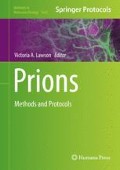Abstract
Misfolding and aggregation of prion protein are related to several neurodegenerative diseases in humans such as Creutzfeldt-Jakob disease, fatal familial insomnia, and Gerstmann-Straussler-Scheinker disease. A growing number of applications in the prion field including assays for detection of PrPSc and methods for production of PrPSc de novo require recombinant prion protein (PrP) of high purity and quality. Here, we report an experimental procedure for expression and purification of full-length mammalian prion protein. This protocol has been proved to yield PrP of extremely high purity that lacks PrP adducts, oxidative modifications, or truncation, which is typically generated as a result of spontaneous oxidation or degradation. We also describe methods for preparation of amyloid fibrils from recombinant PrP in vitro. Recombinant PrP fibrils can be used as a noninfectious synthetic surrogate of PrPSc for development of prion diagnostics including generation of PrPSc-specific antibody.
Access this chapter
Tax calculation will be finalised at checkout
Purchases are for personal use only
References
Zahn R, von Schroetter C, Wuthrich K (1997) Human prion protein expression in Escherichia coli and purified by high-affinity column refolding. FEBS Lett 417:400–404
Mehlhorn I, Groth D, Stöckel J et al (1996) High-level expression and characterization of a purified 142-residue polypeptide of the prion protein. Biochemistry 35:5528–5537
Rezaei H, Marc D, Choiset Y et al (2000) High yield purification and physico-chemical properties of full-length recombinant allelic variants of sheep prion protein linked to scrapie susceptibility. Eur J Biochem 267:2833–2839
Hornemann S, Korth C, Oesch B et al (1997) Recombinant full-length murine prion protein, mPrP(23–231): purification and spectroscopic characterization. FEBS Lett 413:277–281
Jackson GS, Hil AF, Joseph C et al (1999) Multiple folding pathways for heterologously expressed human prion protein. Biochim Biophys Acta 1431(1):1–13
Yin SM, Zheng Y, Tien P (2003) On-column purification and refolding of recombinant bovine prion protein: using its octarepeat sequences as a natural affinity tag. Protein Expr Purif 32:104–109
Bocharova OV, Breydo L, Parfenov AS et al (2005) In vitro conversion of full length mammalian prion protein produces amyloid form with physical property of PrPSc. J Mol Biol 346:645–659
Baskakov IV, Bocharova OV (2005) In vitro conversion of mammalian prion protein into amyloid fibrils displays unusual features. Biochemistry 44:2339–2348
Bocharova OV, Makarava N, Breydo L et al (2006) Annealing PrP amyloid fibrils at high temperature results in extension of a proteinase K resistant core. J Biol Chem 281:2373–2379
Makarava N, Baskakov IV (2008) The same primary structure of the prion protein yields two distinct self-propagating states. J Biol Chem 283:15988–15996
Makarava N, Kovacs GG, Bocharova OV et al (2010) Recombinant prion protein induces a new transmissible prion disease in wild type animals. Acta Neuropathol 119:177–187
Novitskaya V, Makarava N, Bellon A et al (2006) Probing the conformation of the prion protein within a single amyloid fibril using a novel immunoconformational assay. J Biol Chem 281:15536–15545
Bocharova OV, Breydo L, Salnikov VV, Baskakov IV (2005) Cu(II) inhibits in vitro conversion of prion protein into amyloid fibrils. Biochemistry 44:6776–6787
Breydo L, Bocharova OV, Makarava N et al (2005) Methionine oxidation interferes with conversion of the prion protein into the fibrillar proteinase K-resistant conformation. Biochemistry 44:15534–15543
McMahon HEM, Mange A, Nishida N et al (2001) Cleavage of the amino terminus of the prion protein by reactive oxygen species. J Biol Chem 276:2286–2291
Mange A, Beranger F, Peoc'h K et al (2004) Alpha- and beta-cleavages of the amino-terminus of the cellular prion protein. Biol Cell 96:125–132
Ostapchenko VG, Makarava N, Savtchenko R, Baskakov IV (2009) The polybasic N-terminal region of the prion protein controls the physical properties of both the cellular and fibrillar forms of PrP. J Mol Biol 383:1210–1224
Sun Y, Makarava N, Lee CI et al (2008) Conformational stability of PrP amyloid firbils controls their smallest possible fragment size. J Mol Biol 376:1155–1167
Almstedt K, Nyström S, Nilsson KPR, Hammarström P (2009) Amyloid fibrils of human prion protein are spun and woven from morphologically disordered aggregates. Prion 3:224–235
Bocharova OV, Breydo L, Salnikov VV et al (2005) Synthetic prions generated in vitro are similar to a newly identified subpopulation of PrPSc from sporadic Creutzfeldt-Jakob disease. Protein Sci 14:1222–1232
Ostapchenko VG, Sawaya MR, Makarava N et al (2010) Two amyloid states of the prion protein display significantly different folding patterns. J Mol Biol 400:908–921
Acknowledgments
This work was supported by the National Institutes of Health grants R01 NS045585 and NS074998.
Author information
Authors and Affiliations
Editor information
Editors and Affiliations
Rights and permissions
Copyright information
© 2017 Springer Science+Business Media LLC
About this protocol
Cite this protocol
Makarava, N., Savtchenko, R., Baskakov, I.V. (2017). Purification and Fibrillation of Full-Length Recombinant PrP. In: Lawson, V. (eds) Prions. Methods in Molecular Biology, vol 1658. Humana Press, New York, NY. https://doi.org/10.1007/978-1-4939-7244-9_1
Download citation
DOI: https://doi.org/10.1007/978-1-4939-7244-9_1
Published:
Publisher Name: Humana Press, New York, NY
Print ISBN: 978-1-4939-7242-5
Online ISBN: 978-1-4939-7244-9
eBook Packages: Springer Protocols

